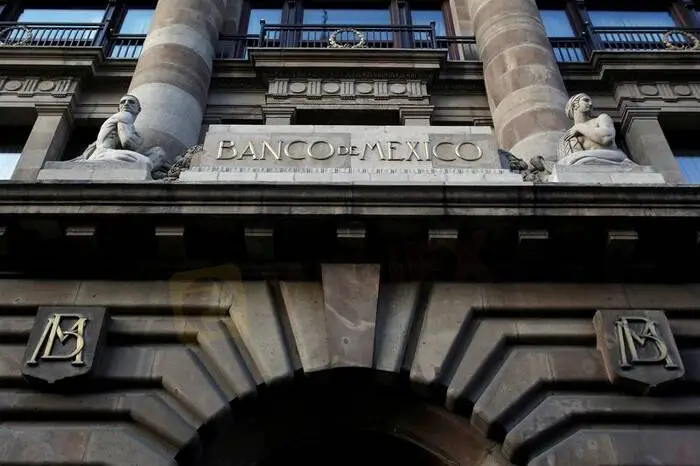简体中文
繁體中文
English
Pусский
日本語
ภาษาไทย
Tiếng Việt
Bahasa Indonesia
Español
हिन्दी
Filippiiniläinen
Français
Deutsch
Português
Türkçe
한국어
العربية
Mexico central bank hikes key rate, still hawkish under new leadership
Abstract:Mexicos central bank on Thursday raised its benchmark interest rate by 50 basis points to 6.00%, a sixth straight rate increase that was in line with expectations, as policymakers sought to keep price pressures in check with inflation running high.

Mexicos central bank on Thursday raised its benchmark interest rate by 50 basis points to 6.00%, a sixth straight rate increase that was in line with expectations, as policymakers sought to keep price pressures in check with inflation running high.
Four of the Bank of Mexicos board, including new governor Victoria Rodriguez, voted for the half a percentage point increase, while member Gerardo Esquivel voted for a 25 basis points hike to 5.75%, the bank said in a policy statement.
Saying “new governor, same script”, Nikhil Sanghani, an economist at Capital Economics, noted Rodriguez had sided with the majority in maintaining the banks hawkish stance.
“As we suspected, the new governor Victoria Rodriguez did not want to rock the boat,” Sanghani said in a research note.
Banxico said in its statement that inflationary pressures have been greater and lasted longer than anticipated, noting that forecasts for headline and core inflation were revised upwards, especially for 2022 and the first quarter of 2023.
The bank underscored that the balance of risks for the trajectory of inflation remains biased to the upside.
Analysts have said expectations the U.S. Federal Reserve will start raising rates would be top of mind for Banxico board members when considering what to do with rates at home.
Core inflation in Mexico in January surged to heights not seen since 2001, and though headline inflation eased slightly to 7.07%, it was still more than double Banxicos target rate of 3%, official data showed on Wednesday.
“With inflation likely to remain well above target over the coming months, the board remaining hawkish under the new governor, and the Fed set to start hiking too, its clear that the tightening cycle has further to run,” Sanghani said.
He forecast three more 50 basis point hikes in the coming months, taking the policy rate to 7.50%. After that, as headline and core inflation eased towards target, “policymakers should take their foot off the brake pedal,” he said.

Disclaimer:
The views in this article only represent the author's personal views, and do not constitute investment advice on this platform. This platform does not guarantee the accuracy, completeness and timeliness of the information in the article, and will not be liable for any loss caused by the use of or reliance on the information in the article.
Read more

Blockchain Decentralization: Empowering a Trustless Future
In recent years, blockchain technology has rapidly evolved from a niche innovation behind Bitcoin into a transformative force across industries. At its core, blockchain decentralization refers to the distribution of authority and decision-making away from a central entity and into the hands of a distributed network of participants. This shift redefines how data is stored and verified and paves the way for trustless, transparent, and resilient systems that challenge traditional centralized models.

The president of @Liberland, @Vít Jedlička come on stage, dialogue on trading security.
The 2025 WikiEXPO Hong Kong Station is about to grandly open. the president of @Liberland, @Vít Jedlička come on stage, dialogue on trading security.

Countdown: 1 day.WikiEXPO2025's first stop, Hong Kong, is about to open.
⏰ Countdown: 1 day. WikiEXPO2025's first stop, Hong Kong, is just tomorrow. Focus on transaction security and explore new investment opportunities. ???? Get ready to start now. See you tomorrow.

JustForex vs JustMarkets: A Comprehensive Comparison in 2025
Selecting the right forex broker can make the difference between trading success and frustration for most investors, especially retail investors. As retail traders gain unprecedented access to global markets, the choice between platforms like JustForex and JustMarkets becomes increasingly significant. Both brokers offer some shining features within the forex and CFD trading space, but their approaches differ in some areas.
WikiFX Broker
Latest News
Global Panic Builds as Forex Shifts into Risk-Off Mode
SEC Fines Velox Clearing $500,000 for SAR Failures
Shocking! Oil Prices Plunge Below $60
BI Alerts Filipinos: Telegram, Facebook Used for Trafficking Scams
AUD/USD Hits New Lows as Panic Selling Unfolds Amid Robust U.S. Jobs Report
FCA Released New List of Unauthorized Brokers
How to protect your money during Black Monday
Singapore Authorities Warned Against WeChat, UnionPay, Alipay Impersonation Scams
Deepfake Scams Nearly Drain $499K from Business
The Rising Trend: Why Forex Brokers Are Investing in Sports?
Currency Calculator







